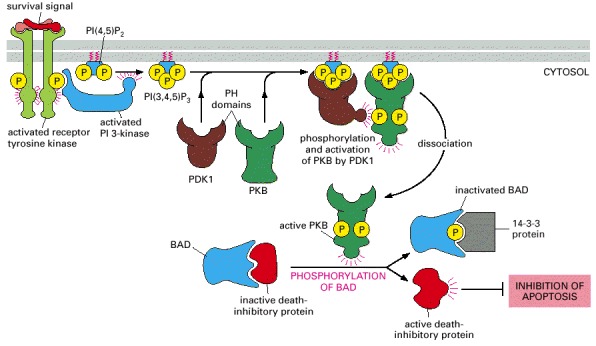From: Signaling through Enzyme-Linked Cell-Surface Receptors

NCBI Bookshelf. A service of the National Library of Medicine, National Institutes of Health.

An extracellular survival signal activates a receptor tyrosine kinase, which recruits and activates PI 3-kinase. The PI 3-kinase produces PI(3,4,5)P3 and PI(3,4)P2 (not shown), both of which serve as docking sites for two serine/threonine kinases with PH domains—protein kinase B (PKB) and the phosphoinositol-dependent kinase PDK1. The binding of PKB to the inositol lipids alters its conformation so that the protein can be phosphorylated and activated by PDK1. The activated PKB now dissociates from the plasma membrane and phosphorylates the BAD protein, which, when unphosphorylated, holds one or more death-inhibitory proteins in an inactive state. Once phosphorylated, BAD releases the inhibitory proteins, which now can block programmed cell death (apoptosis) and thereby promote cell survival.
As shown, once phosphorylated, BAD binds to a ubiquitous cytosolic protein called 14-3-3, which keeps BAD out of action. There are about 20 14-3-3 proteins in human cells, all of which bind to specific phosphoserine-containing motifs in proteins. The activation of other signaling pathways can also lead to BAD phosphorylation and the promotion of cell survival (not shown).
From: Signaling through Enzyme-Linked Cell-Surface Receptors

NCBI Bookshelf. A service of the National Library of Medicine, National Institutes of Health.